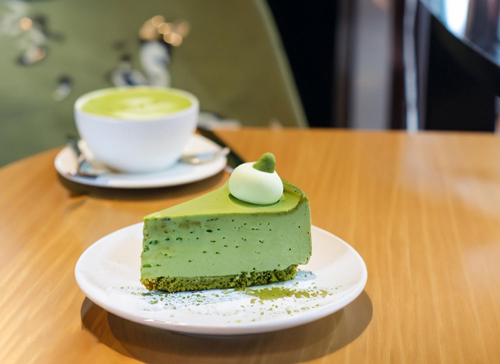In recent years, tea powder has become a rising star in the culinary and baking world. Many commercial clients—from bakeries to restaurants—are exploring its potential to add unique flavors to their creations. With a wide array of tea varieties now being used in desserts, it’s important to understand how differences in grind size (expressed in mesh count) influence tea powder’s flavor performance and applications.

Common Mesh Sizes and Applications of Tea Powder
Mesh Size and Grind Fineness: Mesh size measures the fineness of tea powder—the higher the number, the finer the powder. For context, standard flour is usually 80 to 120 mesh, while ceremonial grade matcha can reach over 1000 mesh. Most commercially available tea powders (non-matcha) are machine-ground and fall within the 100–400 mesh range. Traditional matcha, on the other hand, involves shade-grown leaves, steamed and stone-milled into extremely fine powders of 600 mesh or more.
Application Differences: Coarse tea powder (around 200 mesh) may leave noticeable particles or sediment in the final product. In contrast, finely milled tea powder blends more easily with other ingredients.
Coarse Tea Powder (~100–200 mesh): Ideal for brewing tea base or marinades. Common in applications like tea salt (blended with sea salt) for seasoning grilled meat or tempura.
Mid-Fineness (~300–500 mesh): Suitable for baked goods like cookies and bread, providing balanced tea flavor and color with minimal grittiness.
Fine Tea Powder (~800–1000 mesh): Perfect for high-end applications such as mousses, lattes, or matcha-based drinks. Offers smooth texture and strong flavor without sediment.
| Mesh Size | Beverage Use | Dessert Use | Baking Use | Seasoning Use |
| 100-200 mesh | Not recommended for direct brewing; filter after steeping. | Marinades or fillings with a textured bite. | Needs sifting; flavor less pronounced. | Ideal for tea salt or spice blends. |
| 300-500 mesh | Acceptable in milk teas, smoothies; slight sediment possible. | Cakes, cookies with balanced flavor and color. | Mixes well with batters; vivid green or brown hues. | Dusting over breads or candies. |
| 800-1000 mesh | Premium tea drinks like matcha; fully suspended, no grit. | Fine desserts like mousse, gelato. | High-end pastries with deep flavor and even tone. | Excellent for fine seasoning or sauces. |
(Note: Actual application may vary depending on the recipe.)
High tea’s Low-Temperature Stone Milling: Ultra-Fine Tea Powder
To meet growing demand for premium tea powder, many suppliers are refining their grinding technology. Pei Chen Corp., a leading tea ingredient brand, was the first in Taiwan to introduce Japanese-imported low-temperature stone milling machines, capable of producing ultra-fine tea powder at 800–1000 mesh—on par with, or finer than, ceremonial-grade matcha. While high-mesh tea powder isn’t new to the world, Pei Chen’s approach fills a crucial gap in Taiwan’s high-end ingredient market.
Advantages of Low-Temperature Stone Milling:
- Slow, cool grinding prevents heat-induced oxidation.
- Retains vibrant color, aroma, and nutrients (polyphenols, catechins, amino acids).
- Powder texture is exceptionally fine and smooth.
- Ensures high consistency for commercial clients.
According to some industry reports, a single stone mill may produce only 40g of matcha powder per hour—a testament to its precision and quality. Pei Chen has adapted this traditional craftsmanship to suit local teas, making ultra-fine tea powders accessible for B2B culinary innovation.
Benefits of High-Mesh Tea Powder
- Rich Flavor: Fine particles dissolve and release flavor efficiently, especially in batter and creams. The result is a well-balanced tea taste without residue.
- Healthier Formulation: Tea powder offers full-spectrum nutrition including antioxidants, vitamins, and fiber. Powdered tea contains more nutrients than steeped tea.
- Refined Texture: Ultra-fine powder gives a velvety finish in drinks, sauces, and confections. It won’t leave a sandy feel.
- Stability in Beverages: High-mesh tea powder stays suspended longer, enhancing the drinking experience from first to last sip.
Botanical and Grain Powders: New Tools for Menu Innovation
Beyond tea, High Tea also offers finely milled powders made from herbs, flowers, and grains:
Botanical Powders:
- Hibiscus: Bright red hue and tart aroma for jellies, cream toppings, or mousse.
- Rose: Floral accent for buttercreams, macaron fillings, or East Asian-style pastries.
- Pandan: Southeast Asian leaf with coconut aroma; used in pandan cake or milk pudding.
Grain Powders:
- Black Soybean Powder: High in fiber and protein; used in smoothies, rice cakes, or gluten-free muffins.
- Roasted Brown Rice Powder: Adds toasty notes to cookies and mochi.
- Buckwheat Powder: Adds nutty flavor to pancakes, cookies, or ganache.
These powders are ground using the same fine-mill technique, ensuring vibrant color, fresh aroma, and easy incorporation into recipes. They enable foodservice providers to craft colorful, health-forward menus with authentic plant-based ingredients.

From basic green tea powder to ultra-fine ceremonial-grade matcha alternatives, grinding technology is reshaping how tea is used in modern culinary applications. Pei Chen’s introduction of Japan-imported stone mills marks a turning point in Taiwan’s tea ingredient landscape. Their 800–1000 mesh powders allow local teas to shine in global-level recipes, while also extending to floral and grain powders that inspire chefs and bakers alike. As consumer interest in functional and natural ingredients grows, finely milled tea powders will become essential staples in every innovator’s pantry.




